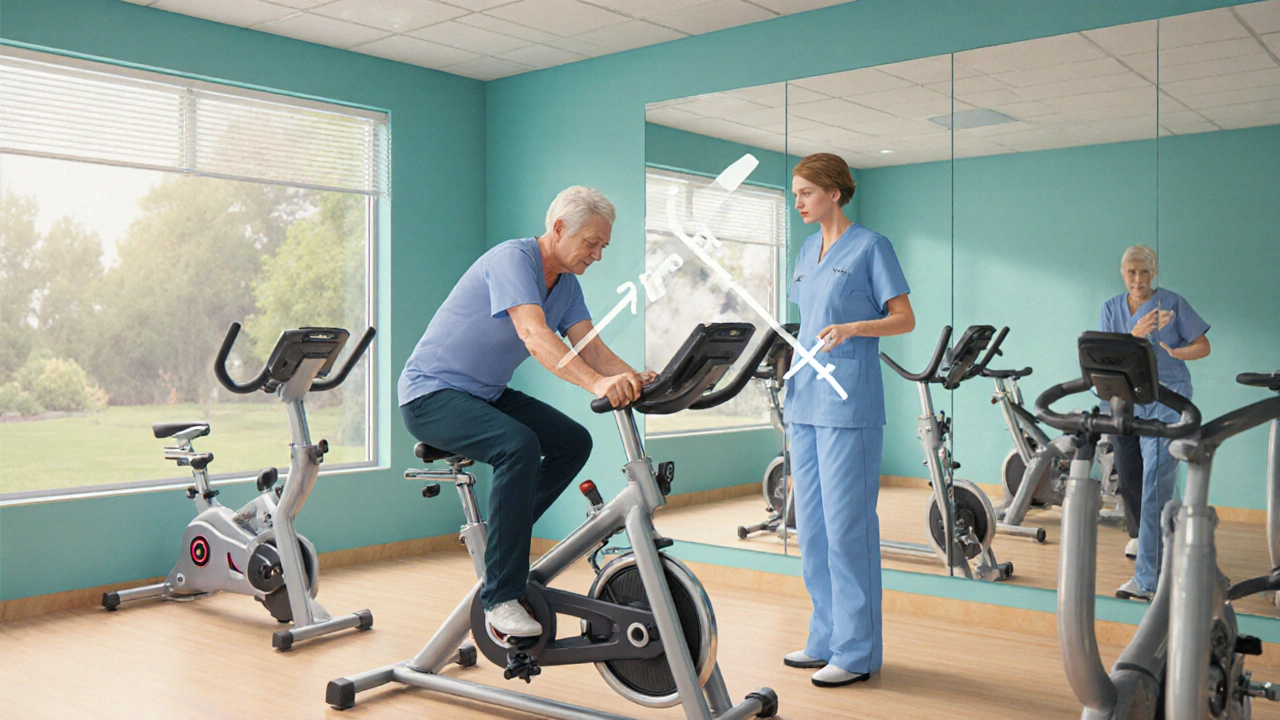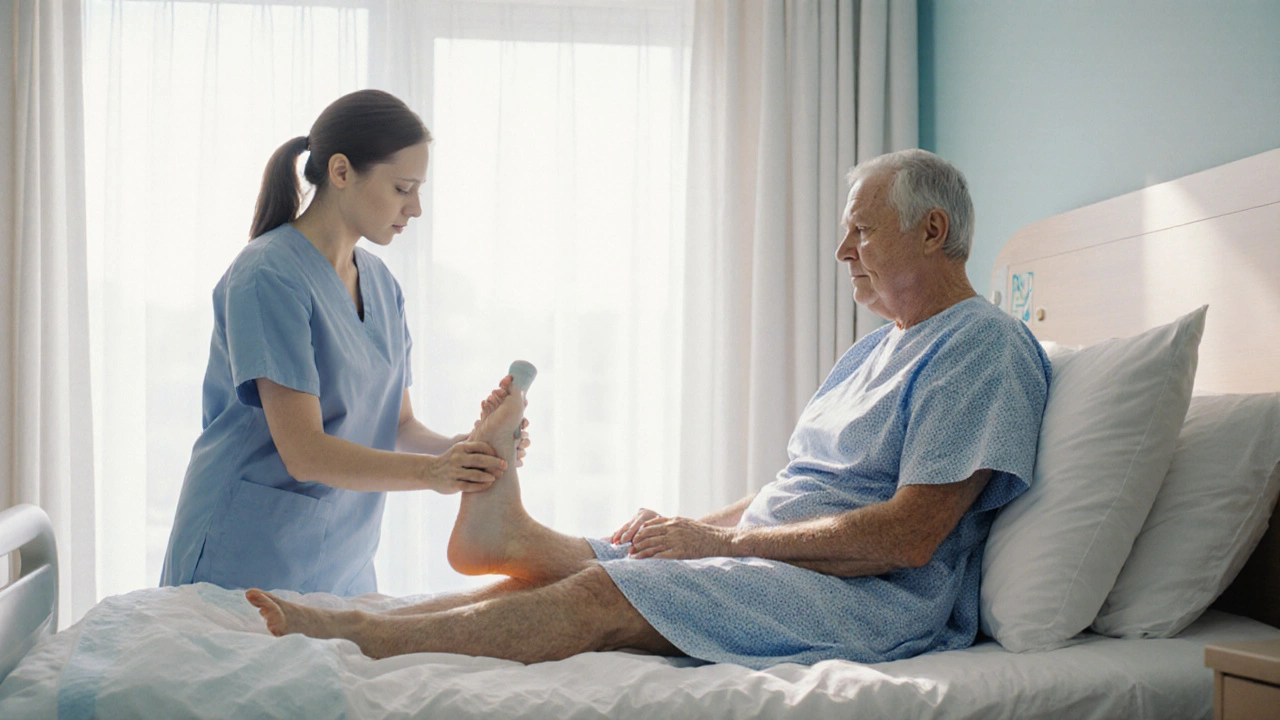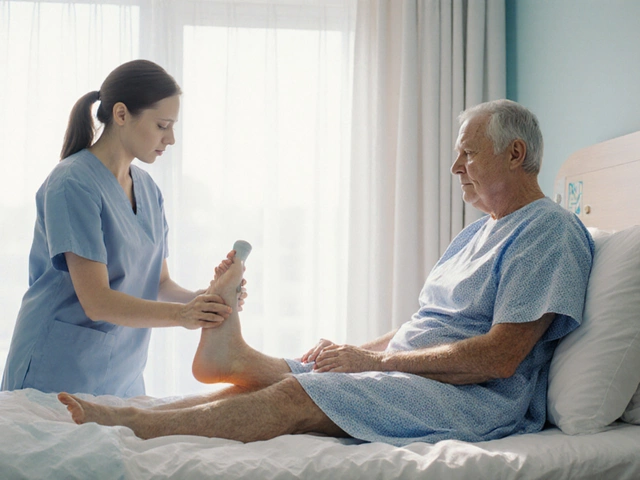Knee Replacement Rehab Stay Calculator
Estimate Your Rehab Stay Duration
Based on factors like age, health conditions, and surgical approach, estimate your typical inpatient rehab stay after knee replacement surgery.
Your Inputs
Estimated Rehab Stay
Enter your details to see your estimated rehab stay duration
When you’re headed for a knee replacement, the big question on most people’s minds is how long they’ll be stuck in rehab. knee replacement rehabilitation is the structured program of physical therapy, pain control, and functional training that starts right after surgery and continues until you can walk, climb stairs, and sit without pain. Knowing the typical timeline helps you plan time off work, coordinate with insurers, and set realistic recovery goals.
Key Takeaways
- Average inpatient rehab stays range from 2 to 5 days for uncomplicated total knee arthroplasty.
- Most patients transition to outpatient physiotherapy for 6‑12 weeks.
- Age, pre‑surgery health, and surgical technique (e.g., ERAS protocols) heavily influence length of stay.
- Early mobilization and home‑based exercises can cut inpatient days without compromising outcomes.
- Understanding discharge criteria lets you negotiate with your care team and avoid surprises.
Why Rehab Length Varies So Much
Even though the surgery itself is standardized, the recovery journey isn’t. Several variables decide whether you’ll spend a couple of days in a hospital rehab unit or head home almost immediately.
- Patient health profile: Diabetes, heart disease, or obesity can slow wound healing and increase the risk of complications, extending the stay.
- Age: Seniors (70+) often need a bit more supervision, while younger, active adults may be cleared sooner.
- Surgical technique: Procedures done under the Enhanced Recovery After Surgery (ERAS) protocol use multimodal pain control, allowing patients to sit up and walk within hours.
- Insurance and hospital policies: Some payers require a minimum inpatient duration, while others favour early discharge to outpatient services.
- Patient motivation: Engaged patients who practice prescribed exercises at home often need less supervised time.
Typical Timeline From the OR to Home
- Day of surgery: After anesthesia wears off, a nurse helps you get a gentle range‑of‑motion (ROM) exercise. You’ll start with ankle pumps and heel slides.
- Day 1-2 (inpatient): Inpatient rehab facility staff focuses on pain management, knee flexion to at least 70°, and getting you on a walker or stationary bike. Most patients achieve safe ambulation within 24-48hours.
- Day 3-5 (if needed): Advanced gait training, stair climbing practice, and functional tasks like sit‑to‑stand are introduced. Discharge criteria include controlled pain, wound integrity, and ability to walk 50meters with assistive device.
- Week 1-2 (outpatient): You attend outpatient physiotherapy 2‑3 times per week. Sessions focus on achieving 0‑90° knee flexion, strengthening quadriceps, and improving balance.
- Weeks 3‑12: Home‑based exercises supplement clinic visits. By week 6 most patients can walk unaided, and by week 12 they usually return to low‑impact activities like swimming.

Inpatient vs. Outpatient Rehab: A Quick Comparison
| Aspect | Inpatient Rehab | Outpatient Rehab |
|---|---|---|
| Typical Length of Stay | 2-5 days (average 3) | 6-12 weeks of scheduled therapy |
| Primary Goal | Safe ambulation, pain control, wound check | Strength, range of motion, functional independence |
| Cost (US estimate) | $2,500‑$5,000 per day | $150‑$250 per session |
| Typical Patient Profile | Older adults, comorbidities, limited home support | Motivated patients with good home environment |
| Key Therapies | Early gait training, stationary bike, pain management | Progressive resistance training, balance work, sport‑specific drills |
Factors That Can Shorten Your Rehab Stay
While you can’t control every variable, a few proactive steps often shave days off the inpatient timeline.
- Pre‑hab: Engaging in a strengthening program before surgery (e.g., quad sets, hamstring curls) improves post‑op muscle activation.
- Optimized pain regimen: Using a combination of nerve blocks, non‑opioid analgesics, and cryotherapy reduces reliance on IV narcotics, which can delay mobilization.
- Nutrition: Adequate protein (1.2‑1.5g/kg body weight) and vitamin C support wound healing.
- Patient education: Understanding the rehab protocol ahead of time reduces anxiety and encourages early participation.
- Family involvement: Having a caregiver at home ready to assist with exercises can convince surgeons that early discharge is safe.
Real‑World Numbers From Recent Studies
A 2023 multicenter analysis of 4,200 total knee arthroplasty (TKA) patients in the United States reported a median inpatient LOS of 3 days for patients following ERAS pathways, compared with 5 days for conventional care. The same study found that 68% of patients were discharged to outpatient physiotherapy, while 22% went directly home with home‑health services.
In India, a 2022 cohort of 1,100 TKA patients treated at tertiary hospitals showed an average LOS of 2.5 days, largely because most surgeons adopted fast‑track protocols and patients were younger (average age 62).

What to Expect at Discharge
Before you leave the hospital, the rehab team will review a checklist. If you meet all the criteria, you’ll get a personalized home‑exercise booklet and a schedule for outpatient visits.
- Pain level less than 4/10 at rest.
- Incision dry and intact.
- Knee flexion ≥90°.
- Ability to walk 50m with a walker or cane.
- Understanding of home‑exercise protocol.
Missing any of these items usually means another day or two under observation.
Tips for a Smooth Transition Home
- Set up a safe space: Remove loose rugs, place a night‑light near the bathroom, and keep ice packs within reach.
- Stick to the schedule: Attend every outpatient session and complete daily home exercises - consistency beats intensity.
- Track milestones: Keep a simple log of knee flexion, walking distance, and pain scores to share with your therapist.
- Stay hydrated and eat protein‑rich meals: This supports tissue repair.
- Communicate: If swelling or pain spikes, call your care team early - catching issues fast prevents re‑hospitalization.
When a Longer Stay Is Warranted
Not everyone follows the average curve. Certain scenarios demand extra days in rehab:
- Complications such as infection, blood clots, or prosthesis instability.
- Severe pre‑existing mobility limitations (e.g., Parkinson’s disease).
- Lack of reliable home support, making safe discharge risky.
- Patients on anticoagulation therapy that requires close monitoring.
In these cases, a stay of 7‑10 days isn’t unusual, and the focus shifts to intensive physiotherapy, wound care, and education.
Frequently Asked Questions
How many days do most people stay in rehab after a knee replacement?
For uncomplicated total knee arthroplasty performed under fast‑track protocols, the average inpatient stay is 2‑5days, with most patients leaving after about 3days.
Can I go straight home without any inpatient rehab?
If you have a strong support system, good overall health, and your surgeon follows an ERAS pathway, you may be discharged on the day of surgery or the next day with a home‑health therapist visiting once or twice a week.
What are the key discharge criteria for knee replacement rehab?
Pain ≤4/10 at rest, incision clean, knee flexion ≥90°, ability to walk 50m with assistive device, and understanding of home exercise program are the typical benchmarks.
Does age significantly affect rehab length?
Older patients often need an extra day or two for safe ambulation and to address comorbidities, but with modern protocols the gap has narrowed considerably.
What can I do before surgery to shorten my rehab stay?
Engage in a pre‑hab program that focuses on strengthening the quadriceps and hamstrings, maintain a healthy weight, and discuss pain‑control options with your surgeon.






